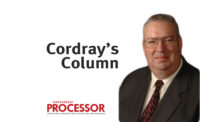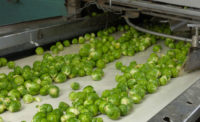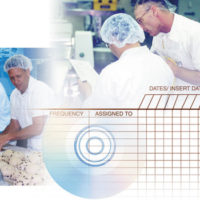When it comes to the foods we eat, defining “clean” has always been a vexing question with a more exasperating answer. The currently adapted 2017 edition of the FDA Food Code is silent on defining “clean.” It does, however, define “clean-in-place” and alludes to “cleanability” without being specific. But nowhere is “clean” given an objective definition. Likewise, Appendix B: Definitions of Food Safety Problems in the Current Good Manufacturing Practices (CGMPS) for Food and Dietary Supplements is also silent on this definition. However, both documents provide ample information to define the conditions of cleanliness without specific regard to either subjectivity or objectivity. The regulatory community expeditiously evaluates cleanliness by declaring a surface “clean to sight and touch.” In other words, cleanliness of a food production facility is in the eye—and feel—of the beholder. This is all well and good if physical cleanliness and the absence of greasy surfaces is all that is needed to ensure a level of microbiological safety, but it isn’t.
Since no clear definition exists, each facility must create its own definition of “clean” and recognize that each definition is both unique and dynamic. What is deemed clean now may not stay clean when subjected to the environment.
While physical cleanliness is straightforward, microbiological cleanliness is a bit more elusive. We look for the presence and absence of specific organisms in much the same way a clinician defines infection. Oftentimes, this is without regard to the dynamics found in the art and science of environmental microbiology. In coming to terms with any definition, there is an amorphous mixture of incompatible and contradictory goals. The late Dr. Velvl William Greene of the University of Minnesota presented a curious mix of our expectations when coming to terms with the idea of sanitization and disinfection:
• We deal in probabilities of survival and deny that any survival is permitted;
• Our plots on semi-log charts do not have a “zero” value, yet we insist on zero chances;
• We insist on “virtual sterility” for some situations and equipment, yet we tolerate much less severe standards for others because of expediency;
• We know that it takes some significant dose of microbes to initiate infections in most humans, and we aim for complete kill–or at least if we find any survivors, we consider it a “failure”; and
• We try to sanitize our environment to the nth degree even when we know that it will be exposed to contaminated surroundings and contaminating situations for several hours.
Measuring Cleanliness
When confronted by these expectations, we oftentimes seek direction in the form of purchasing more, newer, superior, more complex, fiercer, pricier sanitizers along with adjunct technologies to ensure their distribution. Instead, we should consider measuring cleanliness as objectively as we can, justify that level of cleanliness, and actually clean to that level—and do it all with some form of verification.
The concept of objectively evaluating microbiological cleanliness is best illustrated by applying the same simple arithmetical outcome that is used to evaluate sanitizer performance. A sanitizer is expected to destroy 99.999% (or five logs) of a specified test bacterium in 30 seconds under conditions of the Official Detergent Sanitizer Test, also referred to as the Weber & Black Test. This is an actual number, not a probability, and is therefore relatively straightforward to quantify. For example, if the initial bioburden of a surface is 106 (altogether possible in a biofilm), by applying only a sanitizer under ideal conditions, the expected resulting bioburden is 101. However, if that same surface were to be cleaned to a measurable bioburden of 101, when that same sanitizer is applied to the cleaned surface, the expected microbial number is 10–4. It is therefore more desirable to use general sanitation along with customized chemicals and techniques designed for the intended surfaces to be treated in order to achieve the same, if not better, results than to rely on sanitizers alone. By removing food sources used by the offending microbes, we have imposed an additional passive control on that environment.
This is not a denunciation of the use of sanitizers. Quite the contrary. Sanitizers have their place as an essential component in a comprehensive risk control program. However, the overreliance on sanitizers is both counterproductive and has consequences beyond cost.
The second, and probably the most important part of this equation is cleaning. This makes the physical act of cleaning all-important in achieving an established goal of microbiological cleanliness and maintaining that level of cleanliness. Therefore, the reevaluation of an existing sanitation program becomes a critical periodic exercise, as expectations and technology advance. No sanitation program is forever.
Assessing the Sanitation Program
When reevaluating an existing cleaning program to reestablish objective goals and realize optimal returns on investment, tackle the problem through the eyes of a sanitarian. By using good science, a bit of ingenuity, and a lot of attention to detail, we can go beyond the Sanitation Standard Operating Procedures (SSOPs); the chemicals, equipment, and techniques used; and the ingrained tradition of the business. To start, use the guide I.D.E.A. (borrowed from ethical decision making) as a framework to work through this process: Identify, Define, Explain, and Apply.
Identify: This is the basic step to begin the contamination and risk control process. Use every sound sampling and observational technique to quantify those conditions that we can readily see and those that we cannot. This exercise begins by inspecting the facility and processes using applicable codes, regulations, and laws to establish a compliance profile. The inspection is followed by auditing the business’s policies and operating procedures, particularly evaluating the SSOPs against actual practice. The results of the inspection and audit provide a quantitative measure of internal compliance with both risk and contamination control, neither of which needs to be overly detailed to understand what modifications are necessary.
The next phase of identification is process monitoring. This is very much like a plan review. While a good plan review serves to avoid future problems, it also gives us insight on equipment location, floor plans, and material flow; electrical, mechanical, and plumbing system layout; and the start of identifying potential problems associated with each that may affect the overall sanitation program. Additionally, the process monitoring consists of observing—and mapping where necessary—the traffic patterns of people, product, waste, rolling stock, and, most importantly, the actual internal route taken moving raw to finished product.
The capstone of the identification process is sampling. Sampling redefines critical areas within the existing sanitation program. The easiest approach to sampling is to incorporate principles of integrated cleaning and measurement (ICM) in an unbiased manner. This defines and refines the techniques, frequency, and mechanics of the existing cleaning and sanitizing program. ICM applies objective measurements using a uniform template and an ATP monitor in a judgmental or even a snowball sampling scheme. Subjective sampling that was done during the inspection and audit is an important asset used to interpret the ICM results.
Define: Once the results are listed and hopefully stratified according to risk, use “first principles thinking.” This is a fancy way of saying “think like a scientist.” First principles thinking is the best way to reverse-engineer complicated situations and unleash creative possibilities. By doing so, separate underlying ideas or facts from any assumptions based on them. The data collected during the initial identification of the operation are used to separate the complex into its basic essentials. Henry David Thoreau’s quote says it best: “Men have become the tools of their tools…Our life is frittered away by detail. Simplify, simplify.” Therefore, to provide the most concise reevaluation of a sanitation program, apply the principle of Occam’s razor. By using those explanations that have the fewest moving parts, logic and problem solving will yield a workable comprehensive program where details are easily defined, assessed, and corrected as necessary. It is amazing what can be accomplished with a whiteboard and a multidisciplinary team.
Explain: Once the problems are defined, any possible solutions should be subjected to “second-order thinking.” Second-order thinking requires us to consider our actions and their immediate consequences as well as the subsequent effects of those actions. For instance, as stated earlier, we sometimes tend to rely solely on additional sanitizing chemicals without realizing that the overuse of these toxic compounds can (and will) result in the destruction of the biomat at the local sewage disposal plant. This is not a desirable outcome for many reasons. In addition, the regulatory community will eventually require each business to estimate the residual Federal Insecticide, Fungicide, and Rodenticide Act-compliant sanitizer remaining on food contact surfaces after treatment. Therefore, consideration of an entire program with an eye toward consequences beyond the obvious will ensure both cost-effectiveness and cost-efficiency in the long run.
Apply: Once the sanitation program and its outcome are identified, defined, and explained, the critical components of the sanitation program needing improvement become obvious. Now the principles of contamination control to augment the existing sanitation program can be applied; new and modified hygienic zoning can be established; air movement and ventilation can be optimized with a goal to directionality and moisture control; people and materials movement can be delimited to prevent cross- and direct contamination; and individual and process hygiene can be augmented. Finally, a routine inspection and monitoring program can be refined to establish trends and identify potential problems before they become significant.
Conclusions
The definition of “clean” is not without its complexity. There is no single outcome, and neither does one size fit all. No single cleaning methodology, chemical, or technique is universal. The methods and chemicals used will determine initial cleanliness if properly utilized and provide guidance for intermittent cleaning as well as cleaning frequency. Timing determines bioburden, yet the line between cleaning and maintaining cleanliness is often blurred. Therefore, a regular and professional review of the sanitation program and all its component parts is imperative. Timely internal reviews and subsequent changes to the SSOPs will ensure a defensible risk control program for the public’s health.
Forensic sanitarian Robert W. Powitz, Ph.D., M.P.H., RS, C.F.S.P., is principal consultant and technical director of Old Saybrook, CT-based R.W. Powitz & Associates, a professional corporation of forensic sanitarians who specialize in environmental and public health litigation support services to law firms, insurance companies, governmental agencies, and industry.
The Rationale of Redefining a Sanitation Program




